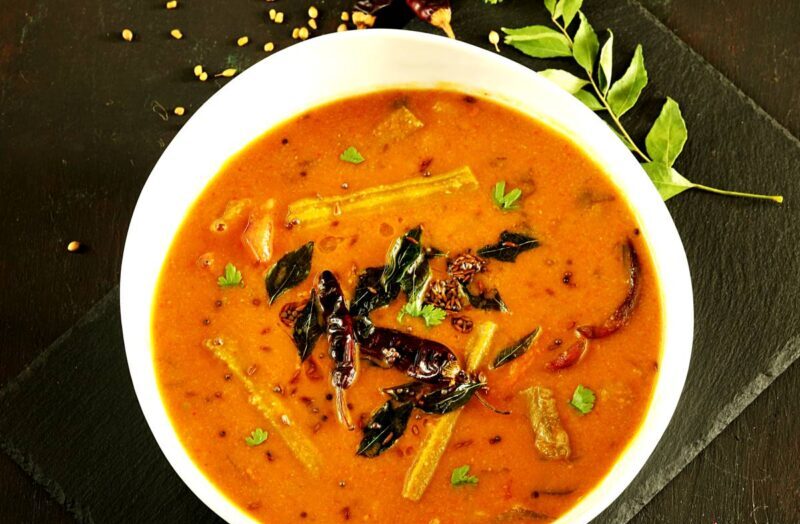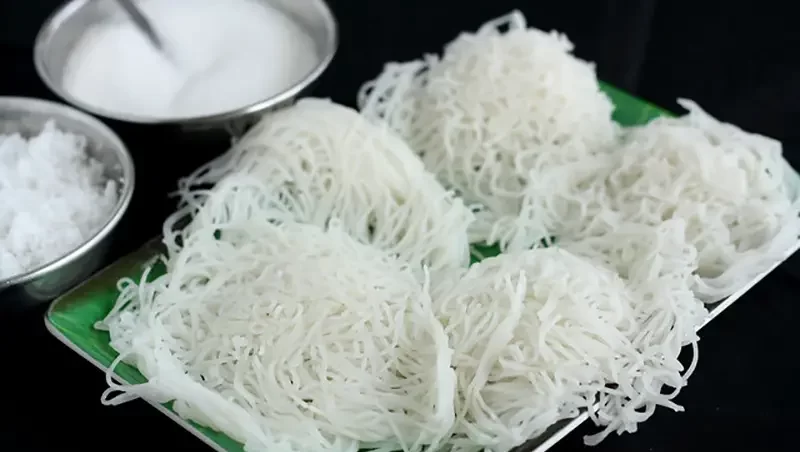Bisi Bele Bath Recipe: The cuisine of Karnataka in South India is renowned for its rich heritage and diverse flavors, offering a plethora of delectable dishes for both vegetarians and non-vegetarians. From Neer Dosa and Mysore Masala Dosa to Mysore Pak and Bisi Bele Bath, the culinary culture of Karnataka is a treasure trove waiting to be explored. In this article, I’m sharing an authentic recipe for Karnataka-style Bisi Bele Bath, a savory dish consisting of rice, lentils, and vegetables.
Bisi Bele Bath, also known as Bisi Bele Huliyanna, is a spicy delicacy prepared by cooking rice, lentils, and veggies together with a blend of South Indian spices and nuts. The key ingredient that imparts its unique flavor is the Bisi Bele Bath powder, a special spice mix used in the dish.
Breaking down the name, ‘Bisi’ means hot, ‘Bele’ refers to lentils, and ‘Bath’ translates to rice in the Kannada language. Thus, Bisi Bele Bath literally translates to Hot Lentil Rice.
My first encounter with traditional Bisi Bele Bath was at an MTR eatery in Bengaluru, Karnataka, recommended by my husband, who is a fan of this dish. I instantly fell in love with its distinct taste and flavors, particularly the unique spice blend and the Marathi moggu (kapok buds) used in the tempering.
The recipe for Bisi Bele Bath is known for its complexity, often incorporating around 30 different ingredients. However, the homemade Bisi Bele Bath powder is a crucial component for its authentic taste. While the cooking process involves preparing rice, lentils, and vegetables separately, the real magic happens during the mixing and tempering stages.
This Bisi Bele Bath recipe, adapted from Pratibha’s Blog, captures the essence of the dish with its rich flavors and aromatic spices. The homemade Bisi Bele Bath powder lends depth and complexity to the dish, making it a truly satisfying meal.
While the traditional method involves cooking each component separately, you can also simplify the process by cooking the dal first and then adding rice and vegetables together in a pressure cooker. The choice of vegetables can vary, but commonly used options include carrots, peas, eggplant, French beans, bell peppers, and chayote squash.
Bisi Bele Bath Recipe Ingredients:
For cooking rice:
- 1 cup rice (such as sona masuri rice)
- ¼ cup raw peanuts
- ¼ teaspoon rock salt (edible and food grade), or regular salt, to taste
- 2.5 cups water, for cooking the rice in a pan
For cooking lentils:
- ¾ cup tur dal (tuvar dal or pigeon pea lentils)
- ½ teaspoon turmeric powder
- 2 cups water, for cooking lentils in a stovetop pressure cooker
For cooking vegetables:
- 1 medium-sized carrot (100 to 120 grams)
- 18 to 20 French beans (80 to 100 grams)
- ½ cup green peas (60 to 70 grams), fresh or frozen
- 3 to 4 small-sized brinjals (eggplants), about 80 to 100 grams
- 1 medium-sized onion, or 2 to 3 shallots (80 to 100 grams)
- 1 medium-sized tomato (80 to 100 grams)
- 1 tablespoon tamarind (tightly packed), soaked in ½ or ⅔ cup warm water
- 2 to 2.5 cups water, for cooking the vegetables
- 1 cup water, to be added later, as needed
- 3 tablespoons Bisi Bele Bath Powder, mixed in 1 cup water
- ¼ tbsp rock salt (edible and food grade), or regular salt, for cooking the vegetables
- 1 teaspoon rock salt (edible and food grade), or regular salt, added later, to taste
- 2 tablespoons unsweetened desiccated coconut
For tempering:
- 3 to 4 tablespoons Ghee or oil
- 1 or 2 Marathi moggu (kapok buds), optional
- 1 teaspoon mustard seeds
- 2 to 3 dried byadagi chillies, dry Kashmiri red chillies, or dry red chilies
- 12 to 15 curry leaves
- ¼ teaspoon asafoetida (hing)
- 18 to 20 cashews
How to Make Bisi Bele Bath Recipe:
- Step 1 – Cooking Rice:
- Step 2 – Cooking Lentils and Vegetables:
- Step 3 – Making Bisi Bele Bath:
- Step 4 – Tempering Bisi Bele Bath:
Step 1 – Cooking Rice:
- Begin by rinsing 1 cup of rice and ¼ cup of raw peanuts. You can also choose to skip adding peanuts at this stage and fry them later during the tempering process.
- Add 2.5 cups of water to the rinsed rice and peanuts.
- Allow the rice and peanuts to soak in the water for 20 to 25 minutes.
- Add ¼ teaspoon of edible rock salt or regular salt to the mixture. Cook the rice on the stovetop without covering the pan with a lid. Alternatively, you can cook the rice in a stovetop pressure cooker (adding 2 cups of water) or an Instant Pot (adding 1.5 to 2 cups of water).
- Simmer the rice until the grains are tender and fully cooked. The peanuts will also be cooked through. Once done, cover the rice and set it aside.
Cooking Lentils and Vegetables:
- Begin by soaking 1 tablespoon of tightly packed tamarind in ½ or ⅔ cup of warm water for 25 to 30 minutes.
- After soaking, squeeze and extract the tamarind pulp into the soaked water. Strain the pulp and set it aside.
- In a 3-liter stovetop pressure cooker, add ¾ cup of rinsed pigeon pea lentils (tuvar dal), ½ teaspoon of turmeric powder, and 2 cups of water.
- Pressure cook the lentils on high heat for eight to nine whistles.
- Once the pressure naturally settles down in the cooker, open the lid and mash the lentils with a spoon or whisk. Set them aside.
- In another pan, place the chopped vegetables and sprinkle ¼ tbsp of edible rock salt or regular salt. The vegetables included are:
- 1 medium-sized carrot, chopped
- 18 to 20 French beans, chopped
- ½ cup of green peas – fresh or frozen
- Three to four small brinjals or baby brinjals (small eggplants), chopped
- 1 medium-sized onion or two to three shallots, chopped
- 1 medium-sized tomato, chopped
- Pour 2 cups of water into the pan with the vegetables and stir to combine.
- Cover the pan with a lid and cook the vegetables until they are fork-tender and cooked well while still retaining their shape.
Making Bisi Bele Bath:
- In the pressure cooker with the mashed lentils, add the cooked rice and peanuts.
- Next, add the cooked vegetables along with their stock to the mixture.
- Gently stir the ingredients together.
- Pour in 1 cup of water or as needed.
- Add the prepared tamarind pulp to the mixture.
- Carefully mix everything together, ensuring that the rice grains remain intact.
- In a separate pan or bowl, combine 3 tablespoons of Bisi Bele Bath masala with 1 cup of water.
- Stir the masala mixture well, ensuring it doesn’t stick to the spoon.
- Pour the Bisi Bele Bath masala solution into the cooker with the cooked rice, lentils, and vegetables.
- Add 2 tablespoons of unsweetened desiccated coconut to the mixture.
- Mix everything thoroughly, adjusting salt as needed.
- Place the cooker without the lid on the stovetop and simmer over low heat for about 15 to 20 minutes, stirring occasionally to prevent burning.
Tempering Bisi Bele Bath:
- Heat 3 to 4 tablespoons of ghee or oil in a small tempering (tadka) pan. Begin by crackling 1 teaspoon of mustard seeds.
- Then, add 12 to 15 curry leaves, 1 to 2 Marathi moggu, 2 to 3 dried red chilies (seeds removed), 18 to 20 cashews, and ¼ teaspoon of asafoetida (hing).
- Fry until the dried red chilies change color and the cashews turn a light golden brown.
- Immediately pour this tempering mixture, along with the oil, into the prepared Bisi Bele Bath and stir.
- Cover the cooker with the lid and let it sit for about 5 minutes to allow the flavors of the tempering to infuse into the bath.
- Serve Bisi Bele Bath with potato chips, banana chips/wafers, or fried papads, along with raita or yogurt. Optionally, top with a bit of ghee before serving.
Expert Tips for Bisi Bele Bath Recipe:
Marathi moggu or kapok buds are essential in the Bisi Bele Bath Masala mixture. If unavailable locally, consider ordering them online. However, they are optional in the tempering of the dish and can be skipped if necessary.
If you prefer, skip adding raw peanuts with the rice initially and fry them in the tempering instead.
Ensure the Bisi Bele Bath is cooked until the raw flavor of the tamarind dissipates and the flavors blend well. Stirring frequently and adding water as needed prevents burning at the base.
Cover the cooker after adding the tempering and let it sit for about 5 minutes to enhance the infusion of flavors.
Adjust the consistency according to preference, but avoid making it too thin.


